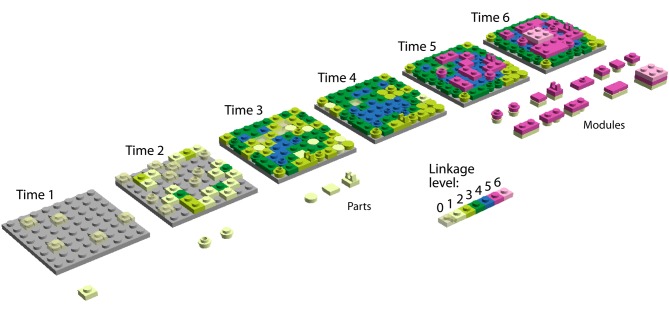Figure 1.
A linkage model of emergence of modules. We illustrate our main hypothesis—diversification and integration of parts unify parts into modules, which then diversify—with the evolution of a system of Lego® blocks. The blocks represent aspects of hierarchical levels of organization in the system. Stud-hole interactions of neighboring blocks and interactions of blocks with walls should in reality be portrayed as multidimensional. Biologically, levels 1, 2, 3, and 4 could represent (for example) levels of organization within proteins—spaces of protein sequences, structures, domains, and quaternary structures, respectively. These levels can be seen as multidimensional spaces in which parts diffuse as they change. We show only three levels as these evolve, with each level materializing in two dimensions—a layer—for the sake of simplicity. Blocks interact only with neighbors and attempt to maximally occupy a space defined by their functionality. Hierarchical level 1 (grey base plate) is a previous space that we will not describe. Hierarchical level 2 develops an increasing repertoire of parts (blocks of different shape in shades of green and blue) and an increasing number of interactions per part (linkage). This increases the connectivity and diversity of parts, with sides of the blocks in contact with others representing extents of linkage 0, 1, 2, 3, and 4. Linkage increases with interactions among blocks; color hues of blocks represent extent of linkage. Hierarchical levels 3 and 4 are only accessible to blocks when linkage extent 4 (dark pink) is achieved, constraining change at levels 2 and below (structural canalization). These interactions enable new extents of connectivity among blocks within and between hierarchical levels and result in modules. In the figure, new block parts and modules in the system are enumerated below the base plates as they appear for the first time in the time series. This enumeration of novelties shows a clear hourglass pattern, which stems from: (1) increasing linkage and limits of space accessibility for blocks due to competitive optimization—this results in percolation in the network of interacting parts, and (2) the rise of modules and new levels of diversification, which increases the evolvability of the system. Note how the discovery of parts reaches a peak, then decreases to zero (hourglass constriction and emergence at time 4) and finally explodes in a combination of modules once hierarchical level 3 is established. Note also how easy it is then to establish hierarchical level 4 (light pink). The basic premise is that a new hierarchical level can only be added if linkage has increased to levels that originate modules (networks of block parts enriched in blue or dark pink). In our model, mutation sometimes generates parts that block formation of modules and top hierarchies (blocks with protrusions or without studs or holes). Competitive optimization and linkage also occur in hierarchical levels 3 and 4 but are not showcased. These additional hourglasses are all interlinked to each other through processes of “sandwiched emergence.”

